Coat Color Genetics
You can also see the different colors as they grow on this page.
To date, there are at least ten known loci that control coat color in gerbils; each locus controls a different trait. Each of these loci has a dominant allele, that usually represents the form of the trait commonly found in the wild, and at least one recessive allele, representing a less common form of the trait. The eight loci discussed on this page are: A, C, D, E, P, Uw, Sp, and Re. I will also touch on Steel-factor, which is a different sort of locus. The loci not discussed include the Semi-Dominant Lethal Spotting and Wavy mutations, which are not known to be present in the USA at this point.
To understand how these loci work, it is necessary to know how color is structured on the hair.

B: The middle band is a golden brown. Because of the way the individual hairs of the coat overlap, this middle band is the most visible, and contributes most to the perceived overall color.
C: The tip of the hair is black, which gives rise to "ticking", the stippled appearance of colors such as Agouti and Nutmeg.
This gray-brown-black pattern causes the wild-colored coat to appear a dark brown.
Navigation
| A-locus | C-locus | D-locus | E-locus | P-locus | Uw-locus | Sp-locus | Re-locus | Steel-factor |
The Sp-locus: Dominant White Spotting and Patch
This locus controls the presence of white areas in the coat. Spotting is a dominant mutation, so the allele for spotting is Sp, not sp. In fact, there is no sp allele. That would be reserved for a recessive mutation. The wild-type allele at this locus is simply written as +, so an unspotted gerbil would be ++. The Sp allele is lethal in the homozygous condition, meaning that all SpSp pups are reabsorbed before birth. So, any spotted gerbil that you see will be Sp+, never SpSp. Initial studies surmised that this reabsorption of SpSp embryos caused smaller litters in an Sp+/Sp+ cross, but breeders today report no reduction in litter size. This is almost certainly because the initial studies were dealing with a similar but separate mutation at the Sp-locus.
The amount of white in the coat can vary tremendously, from gerbils with a single head spot a few hairs wide to gerbils with mottled gerbils with upwards of 75% of their coat being white. The extent of white in a gerbil's coat is determined by gene modifiers. These modifiers have not been isolated as of yet, but you can see the way in which they work.
A mottled gerbil might produce spotted, pied, mottled, and solid pups, all in the same litter. Although they are not mottled themselves, some of the solid pups could carry modifiers for mottling, and go on to produce mottled pups in their offspring. One way to tell if a solid gerbil is likely to produce mottled pups is to look at its paws and chin. On self colors, there is often a white "bib" on the chin, as well as white lines across the paws; in general, the more white there is in these areas, the more extensive the spotting will be in its offspring. For example, a gerbil with only a small amount of spotting paired with a solid gerbil with quite a bit of white might have pied and even mottled pups. A mottled gerbil paired to a solid gerbil with minimal white might only produce spotted and pied pups.
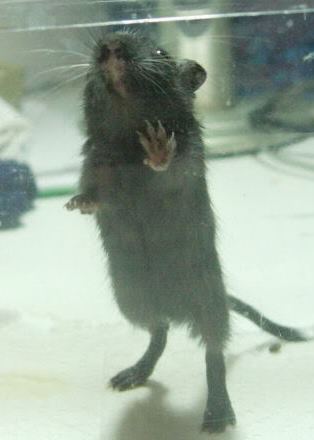
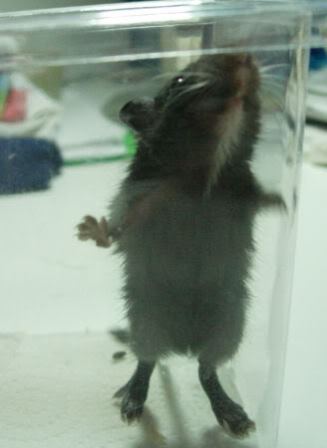
aa C- D- E- P- Uw- ++ :: Solid Black (varying amounts of white)

aa C- D- E- P- Uw- Sp+ :: Spotted Black
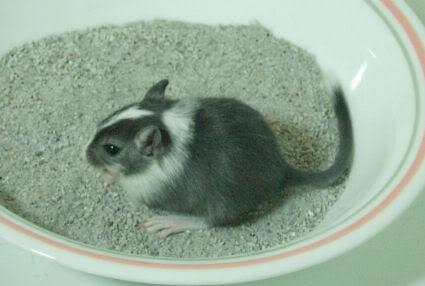
aa C- D- E- P- Uw- Sp+ :: Pied Black

aa C- D- E- P- Uw- Sp+ :: Mottled Black
Spotting also noticeably lightens the base color. A Spotted Lilac, for example, will have colored fur that more closely matches a Sapphire.
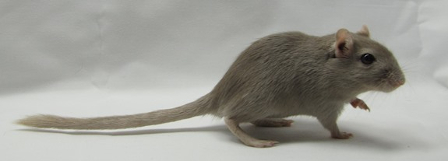
aa CC D- E- pp Uw- ++ :: Solid Lilac
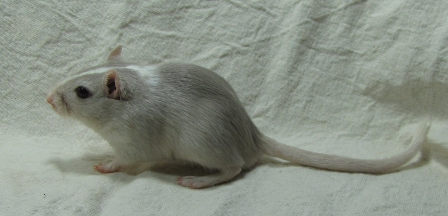
aa CC D- E- pp Uw- Sp+ :: Spotted Lilac
Patched (or Dark-Patch, DP) gerbils have been around for decades, but we are just now discovering the genetics involved. A Patched gerbil has white spotting, but also has patches of unspotted, undiluted fur. Using our earlier example, a Patched Lilac would have areas of white spotting, a basecoat that's been diluted to Sapphire, and areas of solid Lilac. These undiluted Patches can even cover or partially cover areas that would normally be white, such as a head-spot.
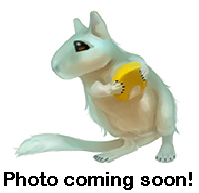
aa CC D- E- pp Uw- Spun+ :: Patched Lilac
Genetically, Patched is caused by localized inactivation of an unstable Sp-locus allele, provisionally called Spun. The instability of the mutation means that some cells will revert to wild-type. These reversions tend to happen in clumps, creating patches of non-Spun fur. Not all genetically Patched gerbils will have a visible dark-patch; whether that's because their reverted cells are occurring internally or there's simply a low reversion rate is unclear. Visibly Patched gerbils can have anything from one small patch to multiple patches covering most of the body.
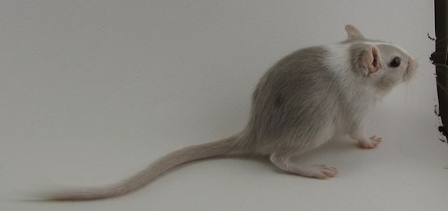
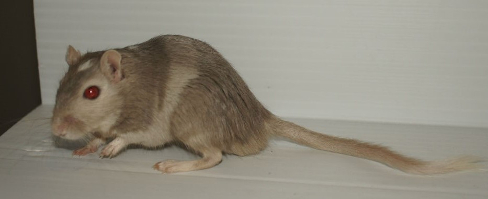
Patched Lilacs, one with a single small hip patch, the other with extensive patching (MS Wildcard, photo courtesy of Moonstone Gerbils)
Like Dominant Spotting, Patched is usually homozygous-lethal, with SpunSpun embryos being reabsorbed early in development. However, a not-insignificant number of unpigmented stillborn and even liveborn-but-short-lived offspring have been reported in Patched lines, so it appears that some SpunSpun are more viable. It's been hypothesized that the pups that continue developing to near-term have "internal patches", large clusters of cells where Spun has been inactivated in key areas that usually fail in an SpunSpun embryo.

Unless otherwise specified, all text and images at this site are licensed under a
Creative Commons Attribution-Noncommercial-Share Alike 3.0 United States License